Guiding Questions
1.Why is summarizing an important skill?
2.How are summarizing concepts and nonfiction works differently from summarizing narrative works?
3.What structures support the summarization of concepts?
Goal
In my previous post, we learned about the “SWBS” strategy from Kylene Beers’ book, When Kids Can’t Read: What Teachers Can Do: A Guide for Teachers 6-12 (affiliate link), that helps ELs summarize narratives.
In this post, I’ll be sharing a mind-mapping strategy to summarize extended nonfiction texts such as essays, news articles or other complex concepts.
Research Says
Complex mental tasks like “summarizing” appear frequently and across multiple disciplines. ELs are as likely to be asked to summarize the concept of “justice” in a humanities class as they are the concept of “systems” in science.
Teaching academic language is a skill that is imperative to helping ELs’ academic success (Freeman & Freeman, 2008; Zwiers, 2008; Frances, et. al., 2006).
It is the responsibility of EAL educators to explicitly teach academic language, in particular command terms like summarizing, in order to develop ELs’ academic language skills (Valdés, 2001).
Past Practices
I found the SWBS very useful in summarizing narratives and attempted to use it to summarize nonfiction texts. The SWBS structure helped students better identify key events when there were people involved.
It worked best for news articles that covered an event. However, when it was time to summarize concepts, such as democracy, EL students left out major components of the concept in their summary statements, indicating the strategy was not as successful.
Current Practices
After reading Making Thinking Visible: How to Promote Engagement, Understanding, and Independence for All Learners (Ritchhart, Church & Morrison, 2011) (affiliate link), I realized I had to use visual structures to make these mental moves more accessible to students. Inspired by the Visible Thinking Routines from Harvard’s Project Zero, I created my own mind-mapping structure to guide students through the process of complex summarization.
To demonstrate the process, I will give an actual example that I used with my 9th grade students in a unit on nonfiction writing. We decided to thematically link to the humanities class which was studying tourism in Laos. We read an article from The Guardian about the impact of tourism on a small Laotian fishing village.
The Steps of Using Mind Mapping to Teach Summarization
1.Outline the Mind Map
First, I shared with students this mind map below. The center and largest circle is the central topic or concept. On the outer orbit of the Central Topic are the Large Ideas, which are connected to the Central Topic. The Large Ideas have minor details that stick out. Then, the Large Ideas are connected to the Central Topic.
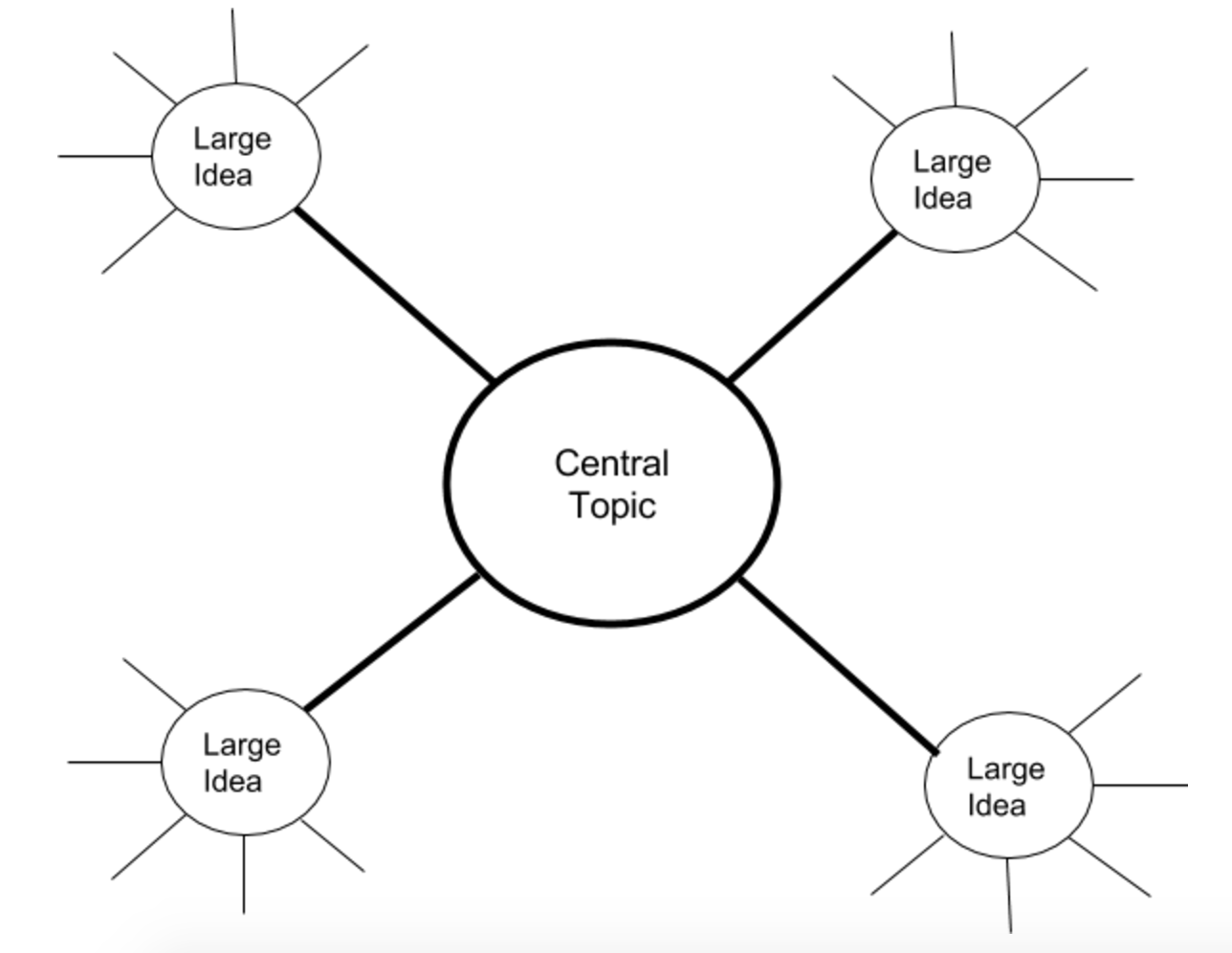
Second, we developed a mind map specifically for our topic that is shown below. “Tourism in Laos” is in the Central Topic circle.
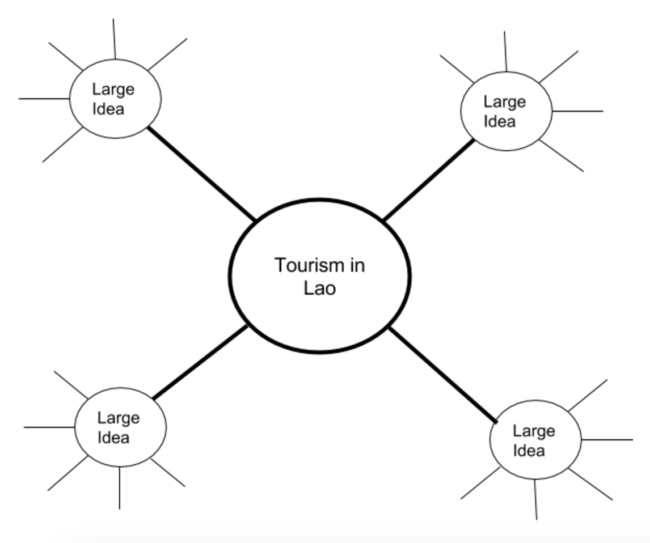
2.Identify Large Ideas
I asked students to list out the “large ideas” that are connected to this topic. I modeled what I requested by identifying two large ideas for the students: “money” and “culture”. Then I asked students to provide more large ideas such as “accidents”, “ecotourism” and “impact on locals”.
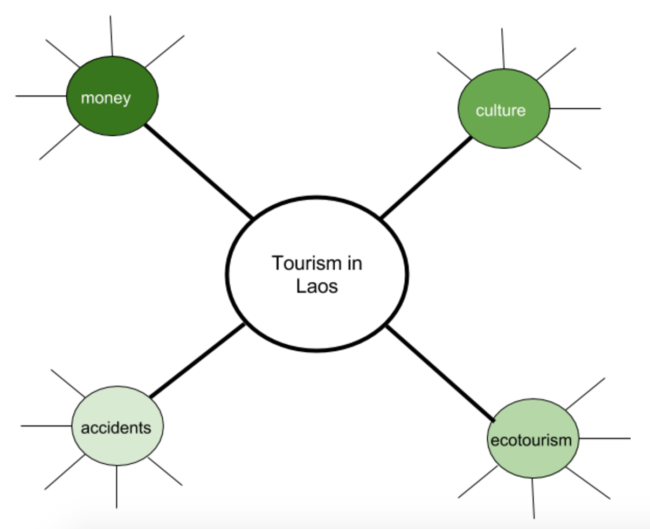 3.Identify Details
3.Identify Details
We then focused on only one Large Idea first by identifying all the details connected to it. My 9th graders started with the “Money” idea first. They said the following:
– Tourism is a big industry in Laos
– Tourism provides money to a village
– Village wants tourism money but still wants its culture to be respected
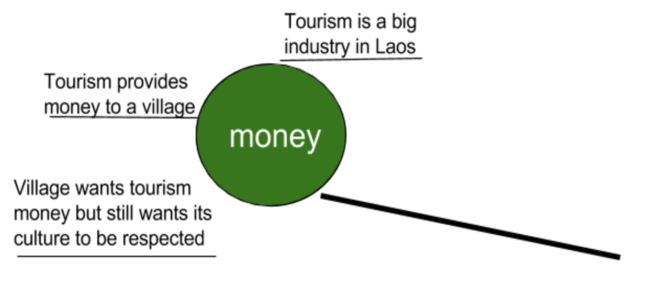
4.Synthesize Large Ideas:
When the “Money” Large Idea was full of supporting details, I guided students to make connections between all of the details. For our “money” Large Idea, students said that, “Money from tourism has both negative and positive effects.” We wrote this “one sentence synthesis” on the line that connects the Large Idea and the Central Idea.
Then we moved onto the remaining Large Ideas and repeated the process. The following times, students were able to take more of a lead since we modeled the first set of steps together.
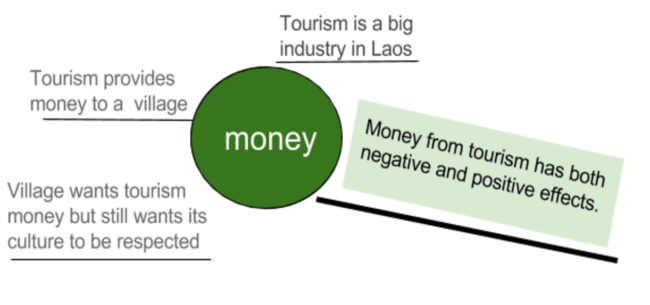
5.Write a Summary:
By this time, all the Large Ideas have been processed. Now students look at their one sentence synthesis statements of each Large Idea and try to combine them into a single cohesive summary that incorporates all the different aspects of the concepts. For our tourism in Laos article, we wrote:
Money from tourism has both negative and positive effects. However, because of the increasing accidents that occur due to drunkenness and drug abuse, both the government and the villagers are struggling to find a role for tourism. The village then has moved from tourism that caters to drinking activities. It now offers many more ecotourism opportunities that will generate income for the village, which will draw the type of tourists who are sensitive to respecting the village’s culture.”
Takeaways
- Summarizing is an important academic skill to master.
- ELs can be taught to summarize rigorous, academic text.
- Teachers can cultivate mastery by using mind-mapping structures that visually teach the mental process.
- This structure can be used successfully across disciplines.
Additional Resources
I briefly introduced Harvard’s Project Zero Visible Thinking Routines, but if you would like to learn more, you can do so by visiting their website. Project Zero provides these routines free of charge. At this site, you will find full descriptions of the routines, examples, videos, and other resources to help you implement these learning structures. The best thing about these learning tools is that they can be used across different content areas because the routines focus on developing thinking and not content matter.
Just as I have created this Summarizing Concept Routine from reading Making Thinking Visible: How to Promote Engagement, Understanding, and Independence for All Learners (affiliate link), other teachers, such as Silvia Rosenthal Tolisano, have also created their own routines to support their ELs.
Next Post
Thank you for spending the time to learn about this routine that can help ELs develop the skill of summarizing complicated concepts and nonfiction ideas. I hope that the information has proven helpful. Please leave comments and questions below.
In my next post, we will continue with our theme of helping students read and understand academic command terms by focusing on the skill of Inferencing. We will return to Kylene Beers book, When Kids Can’t Read, What Teachers Can Do (affiliate link) to teach inferencing skills. Beers’ offers a clear scaffold that makes the invisible act of inferencing more visible for ELs to follow.
Bibliography
Beers, K. (2003). When kids can’t read: What teachers can do. Portsmouth, NH:
Heinemann.
Freeman, Y. S., & Freeman, D. E. (2008). Academic language for English Language
Learners and struggling readers: How to help students succeed across content areas. Portsmouth, NH: Heinemann.
Francis, D. J., Lesaux, N., Kieffer, M., & Rivera, H. (2006). Research-based
recommendations for instruction and academic interventions. Houston, TX: Texas Institute for Measurement, Evaluation, and Statistics at the University of Houston for the Center on Instruction.
Ritchhart, R., Church, M., & Morrison, K. (2011). Making Thinking Visible: How to
Promote Engagement, Understanding, and Independence for All Learners. San Francisco, CA: Jossey-Bass.
Valdés, G. (2001). “Understanding language in schools” … Learning and not learning
English. NY: Teachers College Press.
Zwiers, J. (2008). Building academic language: Essential practices for content
classrooms, grades 5–12. San Francisco, CA: Jossey-Bass.



